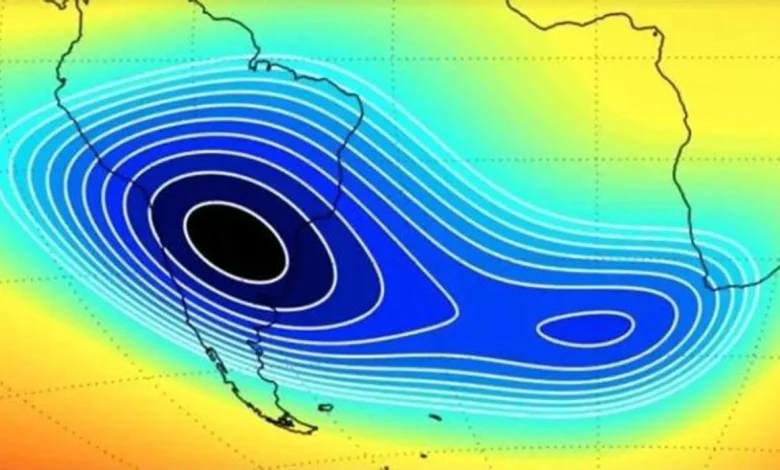The South Atlantic magnetic anomaly: a scientific enigma with global implications

A palpable concern runs through the international scientific community regarding the evolution of a geophysical phenomenon of significant proportions: the progressive weakening of the Earth’s magnetic field over a vast expanse of the Atlantic Ocean.
Formally known as the South Atlantic Anomaly (SAA), this sort of “magnetic depression” located between South America and Africa has not only persisted since its initial detection in the mid-20th century, but has experienced sustained growth in size and a decrease in intensity for at least the last decade.
High-precision data collected by the European Space Agency’s Swarm trio of satellites, launched in 2013, confirm that the anomalous zone currently covers an area comparable to half the European continent.
The origin of this Earth’s protective shield lies in the depths of the planet, where the turbulent movement of molten iron in the outer core acts as a dynamo, generating electric currents that, in turn, produce the magnetic field.
This natural process, however, is far from uniform and has registered fluctuations and even complete polar reversals throughout the planet’s history.
What deeply intrigues researchers is the particularly erratic behavior in the South Atlantic region. Chris Finlay , a researcher at the Technical University of Denmark and part of the Swarm mission team, explained to Science Alert: “We would normally expect to see magnetic field lines coming out of the core in the southern hemisphere. But under the South Atlantic Anomaly, we see unexpected areas where the magnetic field, instead of coming out of the core, is coming back into it.” This reversed pattern suggests the presence of “reverse flow patches” at the boundary between the liquid outer core and the rocky mantle.
The main hypothesis considered by specialists is that this anomaly could be a precursor symptom of an eventual reversal of the magnetic poles, a geological event that occurs gradually over thousands of years .
Although a change in polarity would not necessarily imply the extinction of life, its process would entail a generalized weakening of the field, with potentially severe consequences for modern technological systems.
The reduction in protection against solar and cosmic radiation already represents a tangible risk for satellites orbiting over the area, exposing their electronic components to failures and accelerated deterioration.
Also considered are possible impacts on migratory birds, whose navigation ability depends on the Earth’s magnetism, disruptions in communications and even damage to electrical distribution networks.
Scientists emphasize that the anomaly is not a homogeneous block, but is evolving differently in its African and South American sectors. “Something special is happening in this region that is causing a more intense weakening of the field,” stressed Finlay , who also noted that the phenomenon is shifting.
This geophysical enigma underscores the complexity of Earth’s internal processes and the fragility of the balance that allows life . Continued monitoring through missions like Swarm is crucial to deciphering the ultimate causes of this anomaly and anticipating its implications for a future that, while uncertain, demands an ever-deepening scientific understanding.
IF YOU LIKE WHAT WE DO, HELP US KEEP DOING IT





